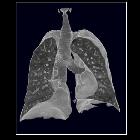tracheobronchomegaly






Mounier-Kuhn syndrome is a somewhat controversial entity and used synonymously with tracheobronchomegaly by most authors .
Epidemiology
Mounier-Kuhn syndrome is most frequently seen in middle-aged men before the age of 50 years .
Clinical presentation
The anatomical and physiological changes present in the airways predispose to stagnation within enlarged portions of the bronchial tree. Therefore, chronic productive cough or recurrent pulmonary infections are commonplace . Clinical features may mimic and often co-exist with COPD .
It is unclear whether Mounier-Kuhn syndrome is a distinct entity or whether it is simply tracheobronchomegaly in the setting of some underlying primary abnormalities. If the latter definition is used, associations include connective tissue disorders such as :
Pathology
The underlying abnormality is an absence or marked atrophy of the elastic fibers and smooth muscle within the wall of the trachea and main bronchi. Although this is thought to be congenital, there is no universal agreement.
As a result of the flaccidity of the wall of the respiratory tree, there is a significant change in airway size during the different phases of respiration. During inspiration, negative intra-thoracic pressure develops leading to marked enlargement of the trachea. However, as expiration commences, the reversed intra-thoracic pressure causes collapse. In addition to this dynamic change, bronchial or tracheal diverticulosis are common, as is bronchiectasis .
There is also an absence of the myenteric plexus of the bronchial tree .
Radiographic features
The most sensitive imaging test is a biphasic CT with images of the trachea obtained during inspiration and expiration. Two-phase chest radiographs will also demonstrate the enlargement of the trachea on inspiration and collapse during expiration, but they are clearly less sensitive.
To consider the diagnosis, the diameter of the trachea should be greater than 3 cm: this is usually measured 2 cm above the aortic arch . Other measurements that have been used to make the diagnosis include bronchial diameters of 20 or 24 mm (right), and 15 or 23 mm (left) .
Posteriorly, projecting tracheal diverticula may also be seen.
Treatment and prognosis
Treatment is usually conservative with physiotherapy and postural drainage. Acute exacerbations are treated with antibiotics. In rare instances, tracheal stenting has been used .
History and etymology
It was initially described by Pierre-Louis Mounier-Kuhn, a French physician, in 1932 .
Differential diagnosis
The differential is that of a dilated trachea.
Siehe auch:
- Trachealdivertikel
- Differenzialdiagnosen bei Tracheomalazie
- kongenitale Anomalien des Tracheobronchialsystems
und weiter:

 Assoziationen und Differentialdiagnosen zu angeborene Tracheobronchomegalie:
Assoziationen und Differentialdiagnosen zu angeborene Tracheobronchomegalie:

